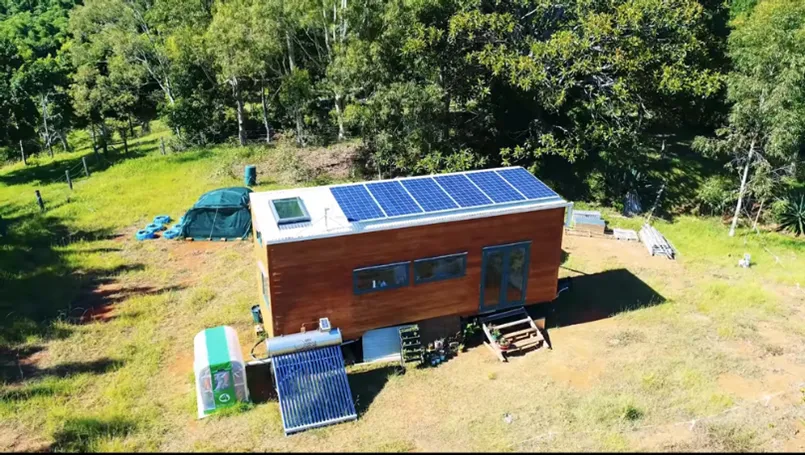27 Sep Living off the Grid in your Tiny Home
Maintaining a tiny home is one thing. Maintenance on an off-the-grid tiny home is a whole other challenge. However, the adventures that await you are worth the hard work. Living off the grid is a big decision, and there are definitely a few precautions you need to take to ensure smooth sailing. Living off the grid can be very enjoyable. But I suggest taking the time to learn, do your research and talk to some folks that are living off the grid successfully. This will make for a much better experience.
Land
First, you’ll need a good location. How do you go about that? Here is an in-depth article explaining How To Find Land For Living Off The Grid. It details how to find and pick the perfect property for your needs. Your land is the foundation of your off grid life. To go off grid, you need a parcel of land that lends itself to your new lifestyle choice. That will usually mean finding land in a remote area, far from strict building codes and permitting regulations. Land in these areas is less expensive, property taxes are lower, and you can get more acreage for your money.

Power
Going off-grid with solar gives you alternative ways to power your home. Solar power is one of the most popular and available options when it comes to off-grid energy. Off-grid living is becoming an increasingly viable choice for those looking for an eco-friendly way to live self-sufficiently. Here’s a good article to review: Off-Grid or Stand-Alone Renewable Energy Systems | Department of Energy.
Staying Safe and Warm
Heating (and cooling) is a necessity and should be on your top priority list. Luckily, there are various ways to heat your off the grid tiny home, and even better, having a tiny home means less space to heat, which makes the job a little bit easier. Historically, fire has been the preferred, affordable choice for off-the-grid living, however, learning how to maintain your fireplace is going to be crucial to avoid accidents. Today, there are several types of fireplaces including, gas, electric, and of course, traditional wood burning. Whichever one you decide on for your tiny home, take the time to research how to care for your fireplace. For example, electric fireplaces are cleaner burning and tend to be safer than the wood-burning type. However, household pets and rodents can chew through the wiring and components, creating a fire hazard. For wood-burning fireplaces, keeping the firebox cleaned and seals well maintained, as well as keeping the chimney clear of debris, is crucial to keep you and your tiny home safe.
Water & Water Collection System
A good clean potable water source is necessary for living off the grid. You will most likely not have access to city water or municipal county water sources on your land so you must choose a piece of land that either has a natural water source, or where it’s convenient to haul water. The other resource you need is a water collection system. This could be something as simple as a rain barrel water catchment attached to your home’s gutter, or a more complex cistern water collection system that collects all the rainwater from your roof. There are actually more sources of water off the grid than many people realize. Wells are the most obvious answer, but there are several other ways to source water sustainably. Off Grid Water Systems: 4 Proven Ways To Bring Water To Your Homestead.

Food
Grow your own food! Since you most likely will not have everyday access to grocery stores and convenience stores to shop for food, you’ll benefit by growing your own in a garden and/or greenhouse. Ideally, it’s wise to have a traditional garden, some raised beds, and a greenhouse full of fruits and veggies. Meat and eggs can also be produced on your homestead if you have it set up for livestock. Also, preserving and canning your own food will allow you to store your food away in a safe place and build up a nice supply of food in case you need it for an emergency. Then your trips to town can be used to stock up on other necessities.
Composting Yard and Kitchen Waste
Like yard waste, food waste scraps can also be composted. Composting these wastes creates a product that can be used to help improve soils, grow the next generation of crops, and improve water quality. EPA estimates that in 2018, 2.6 million tons of food (4.1 percent of wasted food) was composted. In 2018, Americans recovered over 69 million tons of MSW through recycling, and almost 25 million tons through composting.

Permaculture
Using the nutrients in your grey water to fertilize your garden which in turn feeds you is one example of a “designed environment” that creates an ecologically sound way of living. Keeping bees to pollinate your plants that in turn make honey, then feeding the seeds from your plants to chickens producing eggs shows an interconnected system that works in harmony with natural systems. Here is a good website to learn more about permaculture.
Best States for Living Off-Grid?
This list will share some great choices Best States To Live Off-Grid: TOP 29 Picks 2021 (simplyoffgrid.com)
I mentioned earlier do your research, reach out to people who are currently living off the grid,
read as many resources as you can including online blogs and when you’re ready to start living off the grid, you’ll feel more prepared. And, I think you will find that living sustainably can be very rewarding.

Sorry, the comment form is closed at this time.